 Central Citadel Ironclads built 1874-83: SMS Sachsen, Bayern, Würtemberg, Baden. Service until 1910-1920
Central Citadel Ironclads built 1874-83: SMS Sachsen, Bayern, Würtemberg, Baden. Service until 1910-1920
The Sachsen class were called “armored corvettes”, but were four barbette central citadel ironclads, the first steam-only capital ships built by the Imperial German Navy in 1874-1883. Named Sachsen, Bayern, Württemberg, and Baden they were designed for a coastal defense network, from fortified bases, to break up an enemy blockade or landing attempt. Their construction was the result of the French Navy blockade back in the war of 1870. They were Armed with six 26 cm (10.2 in) guns and could manage ironclads if needed. During their active decades they serviced in training exercises and cruises and were comprehensively rebuilt in the late 1890s, although retired before WWI broke out, between 1902 and 1910. They became target ships, torpedo training ship, boom defense hulk.
Genesis of the Sachsen class
The 1870 Franco-Prussian War had been revealing of the need for the neglected Prussian Navy to invest for an efficient defence of her coasts. Indeed, albeit the Prussian Royal army (and its allies) and Napoleon III’s French Imperial Army on land were heavenly matched by numbers alone, the French Imperial Navy absolutely dwarved the Prussian fleet. This was exploited by attempting a large scale blockade of the Jade and Baltic, without success, as the ships were far from their bases without support. But when it was efficient, the effect of the blockade were truly resented. So after the 1871 unification into an Empire, the new Kaiserliches Marine, built upon the core made of the Royal Prussian fleet and aggregates from other Baltic states rebuilt itself, not to be on par with the French Navy, which was closer to the RN at the time and difficult to match, but a be powerful coastal force, enough to deter any blockade or maritime invasion.
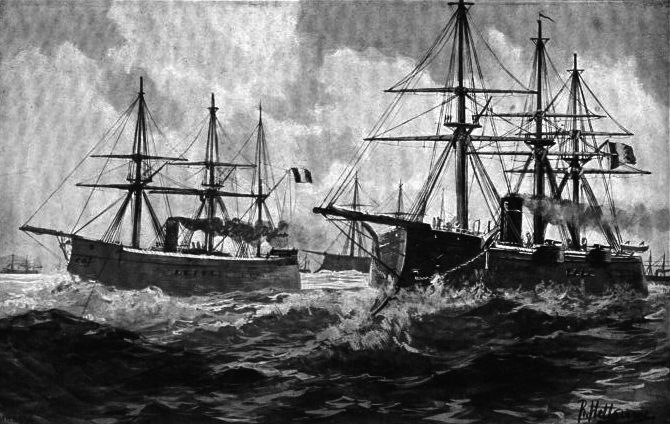
The French Blockade
The origin of the Sachsen class of ironclad corvettes went back even further, to the Prussian fleet plan of 1861, calling for four small ironclads with shallow draught in order to defend the Baltic Sea coast. These were useful to keep at a distance larger armored frigates of a larger draft, unable to close in or maneuver. However through budgetary limitations and Prussian yards technical inexperience as other reasons, this was dropped. Still, the blockade of the Danish Navy during the Second Schleswig War of 1864 was a wake up call; But it was above all the French fleet blockade in the Franco-Prussian War of 1870–1871 that triggered red flags and urged measures to protect the Baltic coastline. After the war and unification, General Albrecht von Stosch became Chief of the Admiralty and started working on a new fleet plan, partly based on the one from 1867.
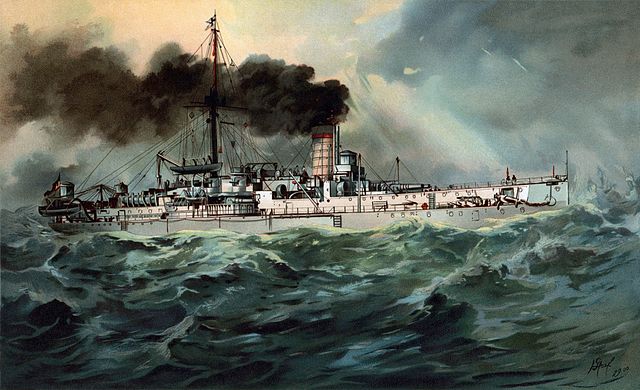
He knew his budget was limited, and the shipyard’s lack of experience and resources were still true, so he devised a mostly defensive fleet of ironclads, with shallow draught and short range in order to be kept in German waters and close to coastal fortifications, also to be built. The fleet plan was finalized in 1873, and called for eight ocean-going ironclads and six smaller armored corvettes. For the first category, there were already many ironclads in service, to the cota of eight was met by the Kaiser class (already laid down in 1872), and the armored corvette SMS Hansa (1872 also). New corvettes were needed, and they were the first large warships ordered under the new Imperial government.
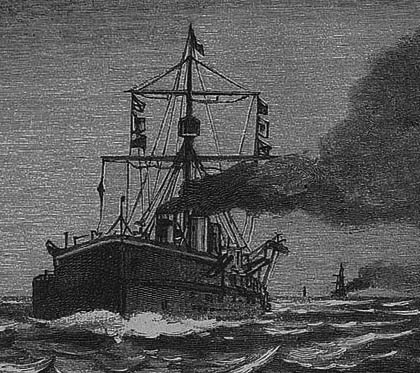 What became the Sachsen class had limitations to operate in the Baltic Sea and to be part of a coastal defense system. Stosch even coined the term “Ausfallkorvetten” (sortie corvettes) for them. They were not sea-going but coastal in essence, short range, yet powerful, and in order to deter a superior naval power attempting a naval blockade. These ships would sail out from their own fortified bases to attack the enemy blockade fleet, and if overwhelmed, withdraw under the safety of friendly fortifications. They were also called for breaking up any landing attempts. The network as envisioned worked with a dedicated railway network to link all these bases along the Baltic coast, and to effectively transfer assets, ground forces notably to meet any enemy landing. Included in the same plan, the smaller Wespe class armored gunboats were also called for support. In reality, they were far from useful in service.
What became the Sachsen class had limitations to operate in the Baltic Sea and to be part of a coastal defense system. Stosch even coined the term “Ausfallkorvetten” (sortie corvettes) for them. They were not sea-going but coastal in essence, short range, yet powerful, and in order to deter a superior naval power attempting a naval blockade. These ships would sail out from their own fortified bases to attack the enemy blockade fleet, and if overwhelmed, withdraw under the safety of friendly fortifications. They were also called for breaking up any landing attempts. The network as envisioned worked with a dedicated railway network to link all these bases along the Baltic coast, and to effectively transfer assets, ground forces notably to meet any enemy landing. Included in the same plan, the smaller Wespe class armored gunboats were also called for support. In reality, they were far from useful in service.
Design of the class
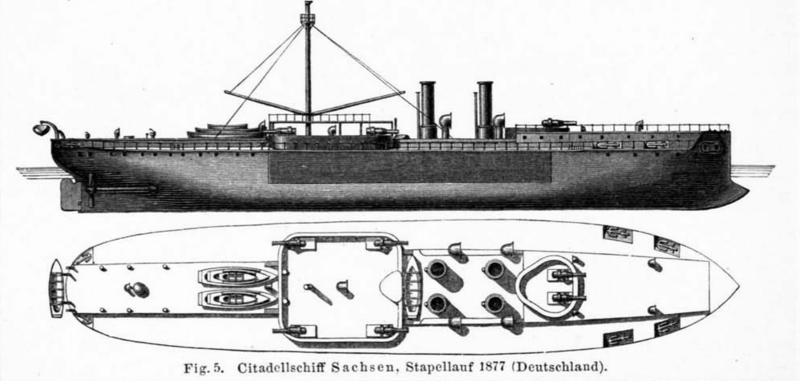
Stosch instructed the design staff about the new design already in 1872, before it was authorized under the 1873 fleet plan. Thuis design work went on until 1874 when SMS Bayern was the first ordered and laid down. There were several design limitations since they were to operate in shallow waters and coastal areas, so the draft needed to be kept as low as possible. They needed to enter indeed any port along the Baltic seaboard, not only naval yards and bases, well dredged by definition. This hull however was still to carry an heavy armament and enough armor plating to resist similar shells hits. They were able to engage any ironclad on equal terms.
Stosch envisioned did not specified top speed or cruising radius constraints and the designers were free to cut down this part. Coal stowage was thus limited, and they were designed to be able to replenish coal from any Baltic port. There was initially a sailing rig planned in 1872, but it was rejected due to the intended role. No long cruises intended. The first choice for armament was to plane them with 30.5 cm (12 in) guns, but the design staff saw it as unproven, still in development, and it was chosen to get back to the lighter and better known 26 cm (10 in) guns already used of previous central battery ironclads such as the Kurfürst and Kaiser classes. The protection and armament repartition base was much inpuired by Royal Navy breastwork monitors, and instead of turrets, that can be heavy and create top weight, endangering stability due to their shallow draft, it was chosen insted to keep open barbettes mountings.
Hull and general design
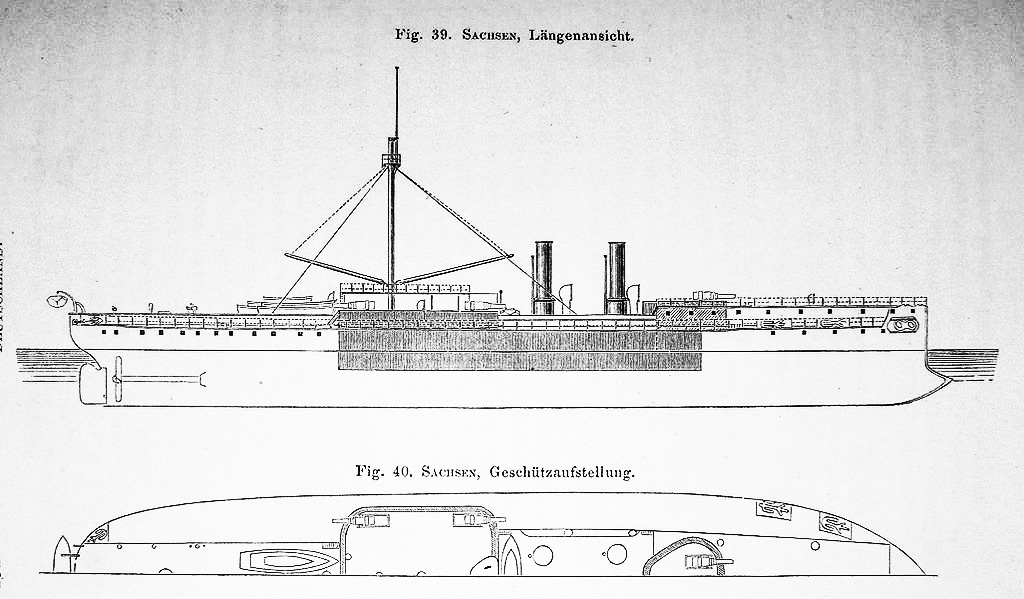
The Sachsen class ironclads measured 98.2 m (322 ft 2 in) long overall for a a beam of 18.4 m (60 ft 4 in) so about 1/5 ratio, and a moderated draft of 6.32 m (20 ft 9 in) forward, 6.53 m (21 ft 5 in) aft. The beam was supposed to compensate for the lack of draft for stability. Still, they were longer and narrower than the previous Kaiser class ironclads. The biggest difference was their lower hull, with a forecastle and recesses for her barbettes, and lower aft deck, streight prow, the ram was underwater.
Displacement was also lighter at 7,635 metric tons (7,514 long tons).
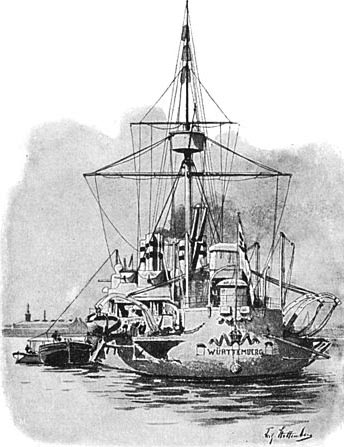 They were not the largest German built ships so far indeed. Fully loaded they approached 7,742 t (7,620 long tons) up to 7,938 t (7,813 long tons) depending on the sisters differences and peculiar loading. Construction was classic, nearly all-metal, calling for transverse bulkheads and double longitudinal iron frames, but with iron plating covered by teak backing. Teak was the only wood type at the time still used by navy navies, adding a very strong yet flexible level or protection that reinforced metal could not bring. Ths hull had a double bottom over 60% of the lenght and was subdivided into sixteen watertight compartments, and that was an innovation: These were the first major warships to adopt internal subdivision. When designed in 1873, the torpedo was not even operational, but spar torpedo vessels were definitely a reality.
They were not the largest German built ships so far indeed. Fully loaded they approached 7,742 t (7,620 long tons) up to 7,938 t (7,813 long tons) depending on the sisters differences and peculiar loading. Construction was classic, nearly all-metal, calling for transverse bulkheads and double longitudinal iron frames, but with iron plating covered by teak backing. Teak was the only wood type at the time still used by navy navies, adding a very strong yet flexible level or protection that reinforced metal could not bring. Ths hull had a double bottom over 60% of the lenght and was subdivided into sixteen watertight compartments, and that was an innovation: These were the first major warships to adopt internal subdivision. When designed in 1873, the torpedo was not even operational, but spar torpedo vessels were definitely a reality.
The crew was comprising 32 officers and 285 ratings, but when used as division flagship, this was seven more officers and 32 assistants. After their 1890 modernization, the crew roset to33 officers and 344 ratings and ended at 35 officers and 401 ratings, making the ship felt cramped to say the least. To evacuate them, there was a fleet of smaller boats: One picket boat for carrying VIPs on shore and back or liaison between fleet vessels, a launch, one pinnace, two cutters, one yawl, and one dinghy. This was customary at the time. Being defensive and not offensive, they carried not dismountable guns or machine guns for landing parties.
Powerplant
The Sachsen class ironclads had two 3-cylinder single-expansion steam engines driving each a four-bladed screw bronze propeller which was five meters (16 ft 5 in) in diameter. These engines came from Märkisch-Schlesische Maschinenbau, und Hütten, AG Germania. Separated engine rooms for these were connected to also separated boiler rooms. In these were located eight single drum coal-fired trunk boilers in two separate rooms. These were truncated and exhausted into four funnels placed in a square amidships. The tandem or paired funnels was not unusual at the time. Only protection, using wider separations pushed the exhasust further apart. Thie earned them the nickname “Zementfabriken” (cement factories). These steam engines also fed three generators providing 69 kilowatts at 65 volts to feed several system onboard.
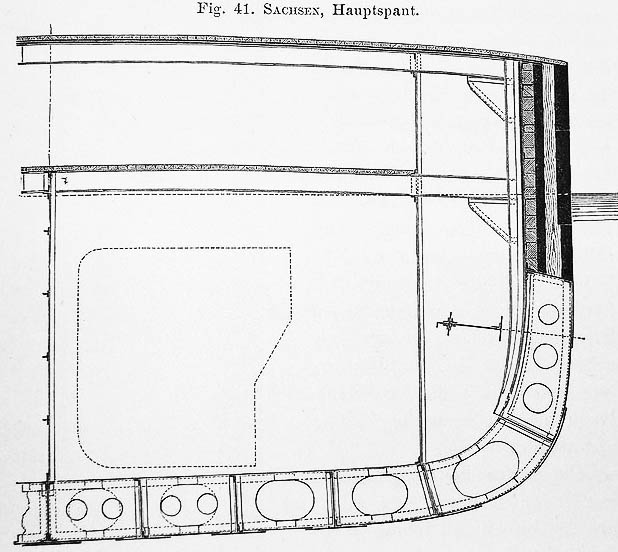
Designed speed was 13 knots (24 km/h; 15 mph) eventually, based on 5,600 metric horsepower (5,500 ihp). But the design and its low draft allowed to exceeded this speed on trials up to 13.5 or even 14 knots, which was alsmot as good as the previous kaiser class rated for 7500 PS. They carried internallu 420 t (410 long tons) of coal and they had enough spaces to carry up to 700 t (690 long tons) for transfer to another sea (via the Skagerrak for example, the Kiel canal was not built yet) if needed. This made for a total of 1,940 nautical miles (3,590 km; 2,230 mi) at a cruising speed of 10 knots (19 km/h; 12 mph) but at 13 knots, this went down to 700 nmi (1,300 km; 810 mi), largely enough to preforme the “interception” of a blockading fleet and back in safety. As said before their mastermind, Stosch, was proposed masts and sails but refused due to their defensive nature and location. They had a single mast as a result, placed aft, with a classic rig but no sail and a boom to lift onboard service boats.
However if speed trials were good, later in service they were revealed as poor sea boats: Severe rolling, and wet in general. But this was met only by heavy weather, more limited in the Baltic. Steering in reverse was limited due to the alternating engine but they kept a very small turning radius, and were responsive from the helm, which was perfect for their role in these waters.
Protection
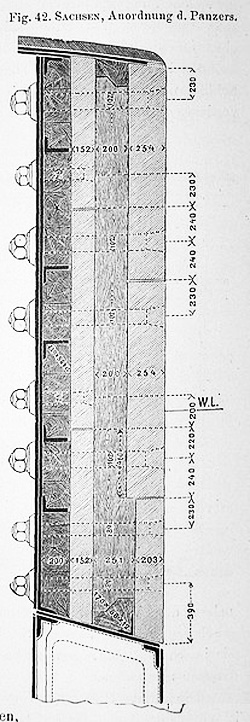 Being central citadel ironclads, they were the first of this kind in Germany, and concentrated both protection and armament amidships in a central section that was 1/3 of the ship’s lenght. Meaning both ends, outside the citadel, were left unprotected.
Being central citadel ironclads, they were the first of this kind in Germany, and concentrated both protection and armament amidships in a central section that was 1/3 of the ship’s lenght. Meaning both ends, outside the citadel, were left unprotected.
-These ships had a short layered iron armor belt made of wrought iron backed by teak planking in succession to absorb hits. It was composed of four alternating layers all sandwiched. The outer iron layer reached 203 mm (8 in) amidships, backed with 200 mm (7.9 in) of teak. The inner layer was 152 mm (6 in) thick backed by 230 mm (9.1 in) teak. This made for a nominal 31 inches (780 mm).
-The citadel was closed by fore and aft 254 mm (10 in) bulkheads.
-Next was the horizontal deck armor, which ranged from 50 to 75 mm (2 to 3 in) in thickness.
-The forward conning tower had walls 140 mm (5.5 in) thick ported to 200 mm (7.9 in) after modernization with a 50 mm (2 in) roof.
-The rear conning tower was only protected by 15 mm (0.59 in) with a 12 mm (0.47 in) thick roof.
-Barbettes for the main guns were 254 mm thick, wrought iron backed with 250 mm teak.
 German industry at the time was not capable of producing iron armor thick enough and so Stosch ordered this plates to Camel & Company of Sheffield in UK. But these were only for the first two, Sachsen and Bayern. For the last two, laid down in 1876, it’s Dillinger Hütte in Germany that was capable of delivering theior armour set. The first German produced armor. Add to the fact these ships were the first with barbettes and steam-only marked a turn in German naval history. But overall this was better than the previous Kaiser class.
German industry at the time was not capable of producing iron armor thick enough and so Stosch ordered this plates to Camel & Company of Sheffield in UK. But these were only for the first two, Sachsen and Bayern. For the last two, laid down in 1876, it’s Dillinger Hütte in Germany that was capable of delivering theior armour set. The first German produced armor. Add to the fact these ships were the first with barbettes and steam-only marked a turn in German naval history. But overall this was better than the previous Kaiser class.
Armament
Main

The Sachsen-class ironclad had a main battery consisting in six 26 cm (10.2 in) L/22 guns. These were two less than the previous central battery Kaiser class, but their positioning in open barbettes gave them much more traverse.
They were placed in a unusual way, with a twin armored barbette forward and a large squared open barbette aft of it, and four main guns in its angles on individual mounts. This meant the forward barbette was a bit better protected than the four aft guns, especially in plunging fire but it was rare at the time.
The placement of the aft forward guns meant forward during a ramming attack, but it was never tested due to potential blast damage.
Engagement ranges were short and ballsitic was in its infancy.
The mountings depressed to −7°, elevated to 16.5° for a range of 7,400 m (8,100 yd).
These guns were supplied with 480 rounds of ammunition.
Secondary
These were likely added after their first modernization. Indeed, they are not even mentioned or shown in the initial blueprints.
For defense against torpedo boat attacks, they had six 8.7 cm (3.4 in) L/24 guns and eight 3.7 cm (1.5 in) Hotchkiss revolver cannons placed between the barbettes and deck.
8.7 cm (3.4 in) L/24 guns: No information on these Krupp guns, ancesorrs of the fampus 8.8 cl developed later, staple of German WWI light artillery.
Hotchkiss Revolver Cannons: 6-barreled 37 mm Gatling style. Needed two loaders.
Construction, reception, Modernizations
Construction

The launching of Bayern
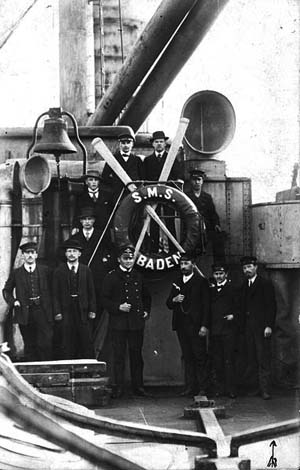 Sachsen became the lead ship, albeit she was laid down shortly after her sister Bayern in 1875 rather than 1874, and at the AG Vulcan shipyard, Stettin (construction number 74). Launched on 21 July 1877 (her sister in 1878) was what make her the first. She was also commissioned first, on 20 October 1878 so a construction time of about four years. AG Vulcan built Württemberg of the second pair from 1876 under construction number 78 and same basin, once freed. Launched on 9 November 1878, she was commissioned on 9 May 1881.
Sachsen became the lead ship, albeit she was laid down shortly after her sister Bayern in 1875 rather than 1874, and at the AG Vulcan shipyard, Stettin (construction number 74). Launched on 21 July 1877 (her sister in 1878) was what make her the first. She was also commissioned first, on 20 October 1878 so a construction time of about four years. AG Vulcan built Württemberg of the second pair from 1876 under construction number 78 and same basin, once freed. Launched on 9 November 1878, she was commissioned on 9 May 1881.
Her sister SMS Bayern was laid down first in 1874 at Kaiserliche Werft, the Imperial Dockyard in Kiel (construction number 3) but launched on 13 May 1878, almost a year after Sachsen for various reasons, notably delays, and commissioned on 4 August 1881. She became thus the third entering service. Baden was laid down right after her in 1876, launched on 28 July 1880, commissioned on 24 September 1883, so after eight years. Their general design was already obsolete by then.
Ships from AG Vulcan needed between three and five years, much faster than the Kiel ships. Still, these construction delays were not unusual in Europe. Bothj in France and Italy it was sometimes close to nine years. The reasons for such delays were design revisions essentially.
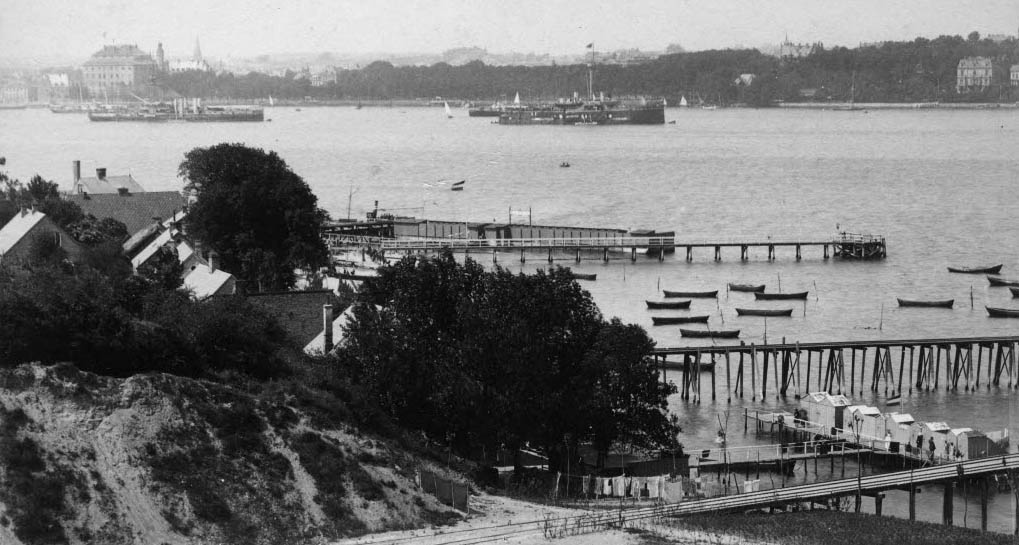

Kiel Yard
SMS Sachsen showed a lot of design issues duing their sea trials so the other three saw their construction stopped and a list of corrective measures and plans alteration followed. AG Vulcan implemented these changes over time, plus shipbuilders experience grew alonside. AG Vulcan indeed was an alrerdy experienced commercial shipbuilder unlike the Imperial Dockyards, just recently founded by the Emperor as the first domestic military naval yard. So construction of the Bayern was important to hone a set of skills and allow in the future faster constructions. Unti; then Kiel’s only construction was the ironclad SMS Friedrich der Grosse, and she was laid down in 1869 but onl completed in 1877. Vulcan AG was faster again, but Kiel did better than Wilhelmshaven yard, also brand new, which needed ten years for SMS Grosser Kurfurst.
A poor reception
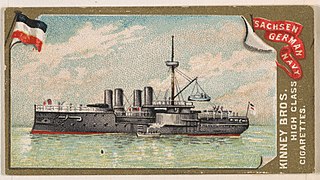 The ships were poorly received once they entered active service and as usual for such specialized tasks, they did less well than more generalist and balanced ships. Given the long construction times, this was an immense danger as technologis advanced rapidly and naval tactics as well. The Sachsens in the end damaged Stosch’s reputation and he was soon derided as a the “Land Admiral” among his peer and in the press. But this was unfair in a sense as the interested recognized himself he lacked the necessary technical expertise taking advises from from senior naval commanders instead. It appeared now largely as a scapegoat for a an “idea of the moment” and they were designed a time there were considerable disagreement in the naval command structure itself, many being disoriented by the rapid transitions from classic wooden-hulled sailing ships to the new generation, using barbette guns, steam only and iron all around, as well as a very young naval policy that was still a work in progress.
The ships were poorly received once they entered active service and as usual for such specialized tasks, they did less well than more generalist and balanced ships. Given the long construction times, this was an immense danger as technologis advanced rapidly and naval tactics as well. The Sachsens in the end damaged Stosch’s reputation and he was soon derided as a the “Land Admiral” among his peer and in the press. But this was unfair in a sense as the interested recognized himself he lacked the necessary technical expertise taking advises from from senior naval commanders instead. It appeared now largely as a scapegoat for a an “idea of the moment” and they were designed a time there were considerable disagreement in the naval command structure itself, many being disoriented by the rapid transitions from classic wooden-hulled sailing ships to the new generation, using barbette guns, steam only and iron all around, as well as a very young naval policy that was still a work in progress.
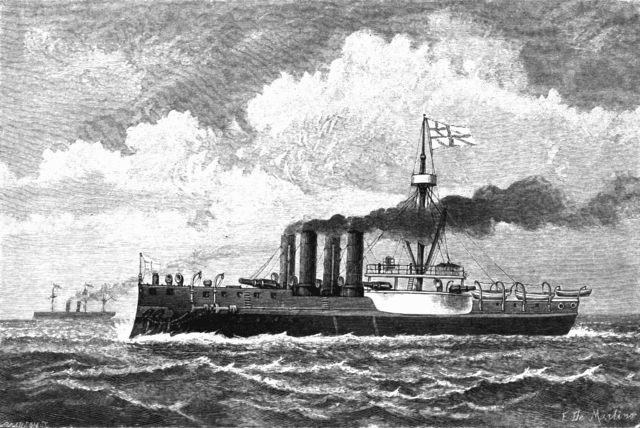
But the Sachsens were important at many levels, as seen above.
-First, they were the first German capital ships with a two-propeller arrangement
-They were the first steam-only capital ships (no sailing rig).
-They were the first with barbettes and a complex, double layered protection
-They very much built experience for the Kiel yard
-They formed the core of the German fleet for a decade, until the arrival pre-dreadnought of the Brandenburg-class.
AG Vulcan nevertheless was contracted by the Qing government to build its two Dingyuan-class ironclads, not willing to order these to imperialistic enemies such as the French and British. These were of a modified Sachsen design and the first major construction exports of Germany to that point. They also had a different main battery arrangement with revolving gun turrets in échelon (like USS Texas among others), giving more experience to the Vulcan Yard. In that sense they were more useful than the “near sister ship” of the Sachsen class, the SMS Oldenburg laid down at Vulcan in 1883 and very much a batardized, cheap and unsuccessful copy of the Sachsen.
Limited modernization
The first modenrization was in 1886: Three 35 cm (14 in) torpedo tubes were mounted per ship. One in a swivel mount placed in the stern, two placed in the bow and submerged. There was a storage for twelve torpedoes in total. At that stage they were all Whitehead or Schwartzkopf models. Also later two more 45 cm (18 in) torpedo tubes were broadside mounted, above water.
The late 1890 saw the most exhaustive reconstruciton of their career, as they were completely obsolete.
-Main engines replaced by more modern 4-cyl VTE.
-New boilers (still coal burning but twice as efficient), all ducted into a single large funnel.
-Top speed 15.4 kn (16.7 to 17.7 mph).
-New battery of six 8.8 mm (3.5 in) SK L/30 guns, four 3.7 cm (1.5 in) guns.
-New Krupp armor fitted to better protect against modern shells.
-Their superstructure was buffed and appearance changed as well.
⚙ Original specifications |
|
| Displacement | 7,635 t (7,514 long tons) |
| Dimensions | 98.2 x 18.4 x 6.32m (322 ft 2 in x 60 ft 4 i x 20 ft 9 in) |
| Propulsion | 2× shafts SE steam engines, 8× boilers 5,600 ihp (4,200 kW) |
| Speed | 13 knots (24 km/h; 15 mph) |
| Range | 1,940 nmi (3,590 km; 2,230 mi) at 10 knots (19 km/h; 12 mph) |
| Armament | 6× 26 cm (10.2 in) L/22, 6× 8.7 cm (3.4 in), 8× 3.7 cm (1.5 in) guns |
| Protection | Belt: 203–254 mm (8–10 in), Deck: 50–75 mm (2–3 in) |
| Crew | 32 officers, 285 enlisted men |
 SMS Sachsen
SMS Sachsen

Sachsen in 1896. Originally she had a black hull and canvas sand superstructures. She was one of the first ships in Europe receiving a test livery of grey-blue.
SMS Sachsen was commissioned on 20 October 1878, made her sea trials in November without armament, revealing structural improvements so she was decommissioned for these modifications as well as her sister Bayern saw her construction suspended at Kiel. Dueing these modificaitons, her lain guns were installed and she underwent a second round of tests, then second decommissioned for further work and alteration. From March to July 1879 she was under KzS Wilhelm von Wickede and KzS Paul Zirzow in May-July.
She entered regular service in 1880 and joined the Training Squadron, officially commissioned on 15 April, decommissioned for the winter on 27 September. and drilled against incursions from France and Russia in case of a new continental war. Further improvements were made and she was recommissioned between 15 February to 12 May 1882 for testing, firing her main guns under KzS Max von der Goltz at a time of high tensions with Russia. She took part in the annual summer fleet maneuvers and was recommissioned on 22 April 1884 under KK Friedrich von Pawelsz and could join her three sisters in a division but was decommissioned on 30 September.
Later assigned to the Reserve Division, Baltic Sea in 1885 until early 1886 she replaced by Bayern after engine damage under KzS Karl August Deinhard. In reserve she remained as guard ship in Kiel. Under KzS Franz von Kyckbusch she was present for the opening of the Kaiser Wilhelm Canal and return to Kiel until November now inactive but with a brief commission by April-May 1888, and by May 1889 she relieved Bayern as guard ship in Kiel and took part in fleet exercises under KzS Otto von Diederichs, making a goodwill visit to Portsmouth for the Cowes Regatta and annual summer exercises, then inactive reserve.
By 1891 she was now on permanent active duty in a new two four-ship divisions, I Division in 1892 under KAdm Hans von Koester and under herself KK Carl Wodrig taking part in the Annual fleet training cruises and summer fleet maneuvers in the North and Baltic seas. She served briefly as torpedo training vessel replacing the screw corvette Blücher and test firing in September off Arendal in Norway. She was commanded by KK Hugo Zeye and later Prince Heinrich of Prussia and replaced SMS Beowulf in I Division making the first winter cruise in the Baltic.
In February 1894 she became squadron flagship and sailed to Scotland and Norway thus summer with Prince Heinrich to Copenhagen on board for the celebrations of the 50th wedding anniversary of King Christian IX of Denmark and Louise of Hesse-Kassel. She was tranbsferred after to the II Division under KzS Rudolf Rittmeyer and by March 1895 earned the Kaiser’s Schießpreis (Shooting Prize), the first time this was awarded. She relieved Baden as flagship in July 1895 under KAdm Carl Barandon and won a second Schießpreis. By December Sachsen and Württemberg remained in the II. division reinforced by the aviso Wacht in March 1896 and the modernized ironclad König Wilhelm, now an armored cruiser and new divisional flagship until the pre-dreadnought Kurfürst Friedrich Wilhelm replaced her under Vizeadmiral August von Thomsen became.
In March 1897, she became flagship of the II Division and escorted the Kaiser to St. Petersburg. By late 1897 she was decommissioned to free her crew for East Asia Division ships and meanwhile she was dry-docked at the Kaiserliche Werft, Kiel for her main modernization until early 1899. She was recommissioned on 25 April 1899 under KzS Wahrendorff and Wilhelm Kindt as flagship of the I Squadron until 26 February 1900 (VAdm Paul Hoffmann). On the 27th at 15:45 she ran aground in foggy weather off Kiel. Her bottom was torn open but she freed herself at high tide and was repaired over 2 weeks. She had later a minor collision with Fürst Bismarck. In July 1900 as the four Brandenburg-class were sent to East Asia for the Boxer Uprising, Sachsen and her sisters went back to the I Division with SMS Kaiser Wilhelm II as flagship. She later joined the Reserve Division of the North Sea as divisional flagship until 5 January 1901 (KAdm Max von Fischel).
By mid-1901 the Brandenburg-class were back and she returned to the II Squadron. On 4 September during manoeuvers she collided with the aviso Wacht, which sank, but she rescued her crew. The aviso attempted to pass between Sachsen and Württemberg but the helmsman misjudged distance and she was rammed by Sachsen albeit she attempted to reverse course. After KzS Max von Basse, she was under her last captain, KzS August von Heeringen. On 3 February 1902, she was decommissioned, reserve, replaced by the dreadnought Kaiser Karl der Grosse.
Towed to Kiel, she remained in the 1st reserve until 1906, 2nd until 19 February 1910, stricken and used as target hulk in 1911 off the coast of Schwansen until late 1918, sold for BU in 1919 in Wilhelmshaven.
 SMS Bayern
SMS Bayern
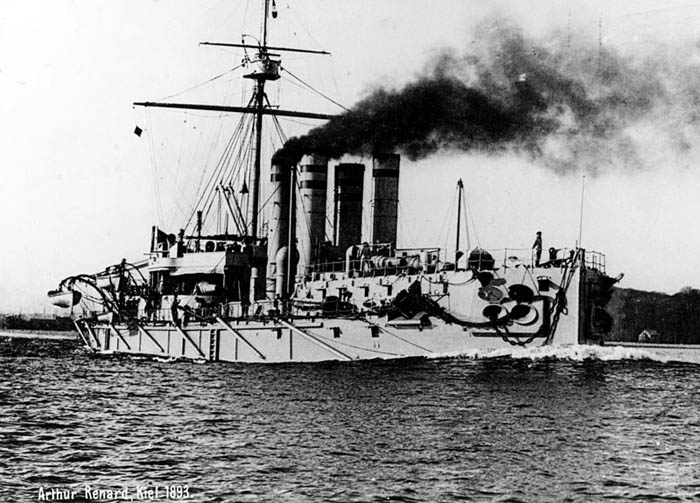
SMS Bayern in 1893
After fitting out, Bayern commissioned on 4 August 1881 and started her sea trials with annual fleet maneuvers in August-September. Like her sister she entered a cycle of shot commissioned, being decommissioned in reserve all winters.
She was so for her first two years and like her sister, she roll dangerously over her flat bottom, reducing accuracy. In 22 April 1884 she was back in her annual training routine in the Panzerkorvette Division under KzS Bartholomäus von Werner and with her sisters, entered the I Division (Konteradmiral Alexander von Monts). Sge was recomm. by May 1885 making a cruise in the north Atlantic to test her in severe weather under KzS Karl August Deinhard and later made the 1885 maneuvers with Friedrich Carl and Hansa off Norway, and the Baltic but she ran aground in the Great Belt, repaired in Kiel. She escorted the Royal Yacht Grille to the Baltic and Memel. By October 1885 August von Thomsen directed her first long range gunnery tests off Curonian Spit. After Casemate guns proved diappointing. From 15 November she became flagship of the Reserve Division.
Together with the Oldenburg in 1886 they trained until 15 May when Bayern was drydocked to fix her troublesome machinery, seeing electric lighting installed, a first in the German navy. Back in active service by 21 November as flagship of the Reserve Division under KzS Franz von Kyckbusch she served with the Panzergeschwader (Armored Squadron) from 23 May 1888 under KzS Gustav von Senden-Bibran and cruised the Baltic with a fleet parade for newly crowned Kaiser Wilhelm II to St. Petersburg, Stockholm, Copenhagen over 70 days. She was flag for the II Reserve Division on 14 September. She was in and out commission but took part in the ceremonial transfer of the island of Helgoland to German control by the summer of 1890 and the state visit of Wilhelm II to Denmark and Norway, then the largest fleet maneuvers yet in September.
By Jan. 1891 under KzS Richard Geissler she sent a landing party in the Kiel parade to honor Field Marshall Helmuth von Moltke. She stayed wit the Maneuver Squadron in the winter of 1891–1892, a first and became guard ship for Kiel. On 16 June 1892 she ran aground in the Kieler Förde and was drydocked for repairs. She took part to complex fleet maneuvers. By October she was the first to receive a new blue-gray paint scheme for tests. She collided collision with the unprotected cruiser Seeadler, light damage.
She was in the fleet maneuvers of 1893 and KzS Hermann Kirchhoff took command while she visited the Russian Baltic Fleet in the 1894 maneuvers and ended in the II Division before the winter cruise of 1894–1895 and after the reorganization of 21 September ended in the II Division with her sisters. The Brandenburgs were in the I Division. She was temporary flagship for Vizeadmiral Hans von Koester in September-November and sailed to the Orkney and Shetland Islands this spring of 1895. She was at the Kiel canal opening review on 21 July 1895, with French officers invited aboard Bayern for a dinner despite diplomatic tensions. Both Divisions trained in the North Sea and Baltic afterwards.
Bayern was decommissioned on 6 October for her major modernization until mid-1897. By mid-1897 she performed sea trials but was fully recom. on 28 May 1898 under KzS Georg Scheder, II Division, flagship of I Squadron under Vizeadmiral Thomsen. The 1899 fleet exercise saw her in Portugal. On 12 September she assisted the aviso Wacht after a boiler explosion, towed to Kiel. On 20 October, she became flagship of II Division, then I Squadron flagship (Vizeadmiral Paul Hoffmann) and decom. in February in Wilhelmshaven, but moved to Kiel in late 1903, Baltic Sea Naval Station, then I Reserve in 1906, II Reserve in 1909, stricken on 19 February 1910, converted as target ship off Stollergrund, Kieler Förde. In 1913 she was used as target for aircraft, cashing in two hits. She remained as so in World War I and was sold on 5 May 1919, BU in Kiel.
 SMS Würtemberg
SMS Würtemberg
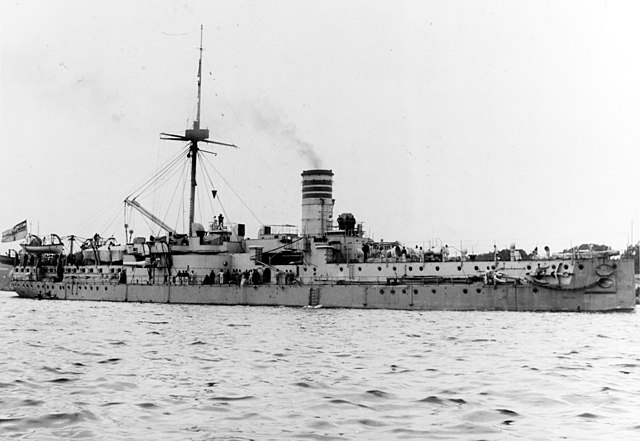
SMS Würtemberg in 1899
She was completed by April 1881, transferred to the Kaiserliche Werft in Kiel for final fitting out but on 24 April she ran aground, stranded for two days, refloated, temporarily commissioned on 9 May 1881 and showcased to representatives from Qing China as the ironclad Dingyuan was in construction.
On 16 May she was decom. for fitting out her main battery. By June she had new sea trials under KzS Max von der Goltz. She was in reserve until April 1884, waiting the completion of her sister ships and poor performance of Sachsen in fleet maneuvers.
From 22 April 1884 she started active service under KzS Hans von Koester in I Division, for the 1884 fleet maneuvers under KAdm Alexander von Monts. She assisted the screw corvette SMS Marie after a collision with SS Hohenstaufen. She was towed to port for repairs. Like her sisters she entered the winter reserve, agains in 1885. By 15 November she joined the Reserve Division but was back in fleet training with her sisters and Oldenburg under KzS Friedrich von Hollmann but her troublesome machinery needs repairs.
She was later back at the Reserve Division, Baltic Sea. In June 1887 she was present at the start ceremony of the Kaiser Wilhelm Canal. from 28 May under KzS Franz von Kyckbusch she was a guard ship at Kiel and late this year ended in II Reserve Division.
Würtemberg was active from 2 May 1890 under KzS Alfred von Tirpitz (yes, this one !) and joined I Division when the eight ships simulated a Russian fleet blockading Kiel. She was in reserve during the 1891 maneuvers but not on 1892, from 8 August under KzS Alfred Herz she replaced Oldenburg in the summer manoeuvers, but accidentally collided with the frigate Friedrich Carl off Stolpmünde. Her steering gear was badly damaged so she was towed to port by the ironclad Deutschlan. Under Max von Fischel she stayed in the I Division in 1894, then under KzS Curt von Maltzan and ended in the II Division for winter training cruises and autumn fleet exercises. On 21 June 1895 she attended the Kiel canal ceremonies and fleet review, then autumn 1895 maneuvers with both divisions between the North Sea and Baltic. While under KzS Karl Ascher on 24 October 1894 she ran aground in the Great Belt but was undamaged.
Until 10 March 1896 she was flagship of I Squadron under VAdm Koester and was in 1896 and 1897 maneuvers being part time flagship all this time under VAdm August von Thomsen, as well as flagship, II Division (KAdm Felix von Bendemann) but on 6 December had an an accident and she was decommissioned for repairs on 15 January 1898 at the Kaiserliche Werft in Kiel followed by her extensive reconstruction until recommissioned on 8 October 1899 under KzS Hugo Westphal.
After sea trials she was back in the II Division, I Squadron, then Div. flagship for KAdm Wilhelm Büchsel, deputy squadron commander until 24 January 1900. During the boxer uprizeing she was part of the I Division with Kaiser Wilhelm II as squadron flagship. On 1 October, she was in the Reserve Division, North Sea under KzS Eduard Holzhauer, I Squadron in early 1901 between exercises and cruises, and under KzS Carl Friedrich back to the II Div. for a cruise to Norway, Ulvik and back to Germany, the autumn maneuvers. Württemberg was back at the Reserve Division, North Sea, in Wilhelmshaven under FK Otto Hoepner. 1902-1903 repeated the cycle with another cruise to Norway under KzS Carl Schönfelder and on 29 September 1903, Württemberg was decommissioned, reserve, transferred to the Baltic on 2 January 1904, and until 1906.
She was selected to replace the old corvette Blücher as torpedo training ship, converted: Main battery guns removed, empty barbettes converted into classrooms, additional living spaces adn she was recom. on 26 September under KzS Fritz Sommerwerck. She was based in Flensburg-Mürwik on 14 October. Uranus (a former ironclad) became her support hulk after Blücher. She sortied on April 1907 for central Baltic exercises as the “Training Squadron”, including the armored cruisers Prinz Adalbert and Friedrich Carl, and light cruiser Vineta. KzS Johannes Nickel took command for two years and for the fleet maneuvers she was in the Reserve Squadron under KzS Felix Funke, for three years. On 10 December 1909 she ran aground in the Firth off Holnis. 1910 and 1911 went uneventful and she was listed as battleship until 28 March 1911. By February 1912 she became emergency ice breaker to assist four merchant vessels trapped in the Baltic in winter. From October 1912 under KzS Georg von Ammon she took part in exercises off Swinemünde but on 11 April 1913 under a severe snow storm forcing her into Möwe Bay she drifted into shallow water, grounded. She ws assisted by other ships and pulled free. Instead of be replaced by the armored cruiser Fürst Bismarck, in August 1914 under FK Reinhold Schmidt she stayed in her role. By early 1915, she resumed her TS activities under KzS Wilhelm Adelung until February 1917 and was decommissioned on 1 February 1919. She was a barracks ship and tender for F-type minesweepers (6th Minesweeper Half-Flotilla) to clear the Baltic of mines. She was decommissioned on 10 November 1919, stricken on 20 October 1920, sold for BU in Wilhelmshaven.
 SMS Baden
SMS Baden
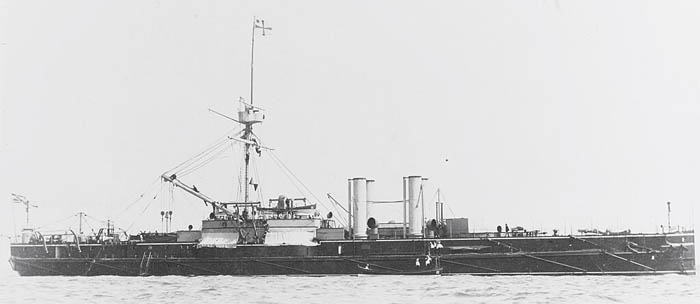
SMS Baden was built under contract name “C” in Kiel and commissioned for sea trials on 24 September 1883, until 22 October. She missed that year’s fleet maneuvers but became flagship for Konteradmiral Alexander von Mont, assigned to I Division with the aviso Blitz. By April 1884, Kapitän zur See Victor Valois took command and participated in realistic scenarios during the 1884 training year notably to foil a mick landing off Godingen with the 1st Life Hussars Regiment. She assisted the screw corvette SMS Sophie after she collided with SS Hohenstaufen and trained in the Baltic Sea for a mock attack on Kiel and decommissioned for the winter on 30 September, a routine that will be repeated several times in her early career.
In 1885 she was chosen to test anti-torpedo nets aboard ships under KzS Max Plüddemann. Under the Maneuver Squadron she remained flagship for Vizeadmiral Wilhelm von Wickede. She tested at sea communication in the western Baltic, and cruised to Skagen Odde, and took part in a mock attack on Wilhelmshaven and blockade in Danzig Bay observed by Caprivi and Prince Wilhelm until 22 September. After the Maneuver Squadron was disbanded for the winter she was back in reserve but was at the Kiel canal review on 6 June 1887. Fully active in early 1888 she was flagship on 23 May when Wilhelm II accessed the throne. She was hosting KAdm Eduard Knorr the fommowing summer and assisted the steamer SS Nord which caught fire in Kiel. After cruise in the Baltic attended by the Kaiser, she went to St. Petersburg, Stockholm, and Copenhagen, hosting dinners and parties for Alexander III, Oscar II and Christian IX respectively but ran aground twice.
Back to Danzig on 31 July, she led a mock attack on Kiel to train coastal defenses. She trained with the TS Squadron and two flotillas of torpedo boats, to the Baltic, North Seaand back to the Jade Bay, observed by VAdm Monts. During the winter her unit became the II Reserve Division.
On 1 May 1889, she was recom. as squadron flagship for KAdm Philipp von Kall, I Division, for large fleet training exercises interrupted by a cruise to Great Britain in August 1889 with the Kaiser Wilhelm II took at the Cowes Regatta from his yacht Hohenzollern. She held a fleet review for Queen Victoria and annual maneuvers as flagship and she ended as guard ship in Kiel. In October she was here to gun salute a British ironclad squadron and later Alexander III of Russia and his squadron.
For the next year’s exercises, two full torpedo-boat divisions were tested. She again escorted the Emperor on state visits to Denmark and Norway. She was there when the island of Helgoland was traded back to Germany (Heligoland–Zanzibar Treaty). On 29 August she saluted the visit of an Austro-Hungarian squadron. The Fleet maneuvers of 1890 saw a simulated Russian attack on Kiel with the IX Corps of the German Army making a simulated amphibious invasio at Düppel and Alsen. She was in the winter again guard ship in Kiel and replaced by Bayern by January 1891 for her extensive overhaul, recommissioned on 1 May 1891, I Division, Maneuver Fleet under Capt. Deinhard and KzS Richard Geissler, her unit reinforced by the coastal defense ship Siegfried as flagship.
On 26 June she assisted the ironclad Kaiser, running aground on an unmarked shoal and the manoeuvers saw Franco-Russian and Danish-Russian alliances secenarios being tested. She remained operational in the winter 1891–1892 and resumed guard ship duties in Kiel. Baden however ran lightly aground off Langeland under KK Richard Hornung.
By 1892, KzS Alfred von Tirpitz became the new chief of staff and started to develop modern fleet tactics and so II Division started a new cycle of manoeuvers under VAdm Wilhelm Schröder and KzS Claussen von Fink as ship’s commander, then KzS Ernst Fritze. Alexander III came aboard Baden in Kiel. The autumn fleet maneuvers under Tirpitz comprised ten ironclads, three corvettes, five avisos, twenty-eight torpedo boats trying new combined maneuvers and resolved questions about fleet tactics. In 1892, Baden and Bayern had a blue-gray paint scheme, tested positive in trials and later applied to all home waters ships from 1895. 1893 was routine for Baden.
Baden suffered an accidental shell explosion in shooting practice at Strander Bucht on 2 August, killing 9, badly wounding 18. The autumn fleet maneuvers followed from 20 August to 23 September. The “Service Regulations IX” were set in place for future training exercises under Goltz and Tirpitz, followed by the first Naval Law in 1898. In 1894 Baden no longer served as fleet flagship, overtaken by the pre-dreadnought battleship Wörth. In the II Division she remained flagship for KAdm Otto von Diederichs from 25 September, then KAdm Carl Barandon herself under KzS Max Galster and KzS Oscar von Schuckmann. They conducted training cruises this winter and spring, and annual autumn fleet exercises. From 21 June 1895 she assisted to the Kaiser Wilhelm Canal opening ceremonies and parade. The Autumn 1895 maneuvers saw a high-seas battle between I and II Divisions in the North Sea, the combined manoeuvers in the Baltic.
On 9 April 1895, she tried to pull free the protected cruiser SMS Kaiserin Augusta, running aground at Kieler Förde. Under Kapitänleutnant Hermann Lilie she was in drydock for periodic maintenance and later was in the autumn fleet maneuvers under KzS Friedrich von Weitersheim and squadron flagship, then decommissioned in Kiel on 11 December for a major reconstruction at Germaniawerft shipyard.
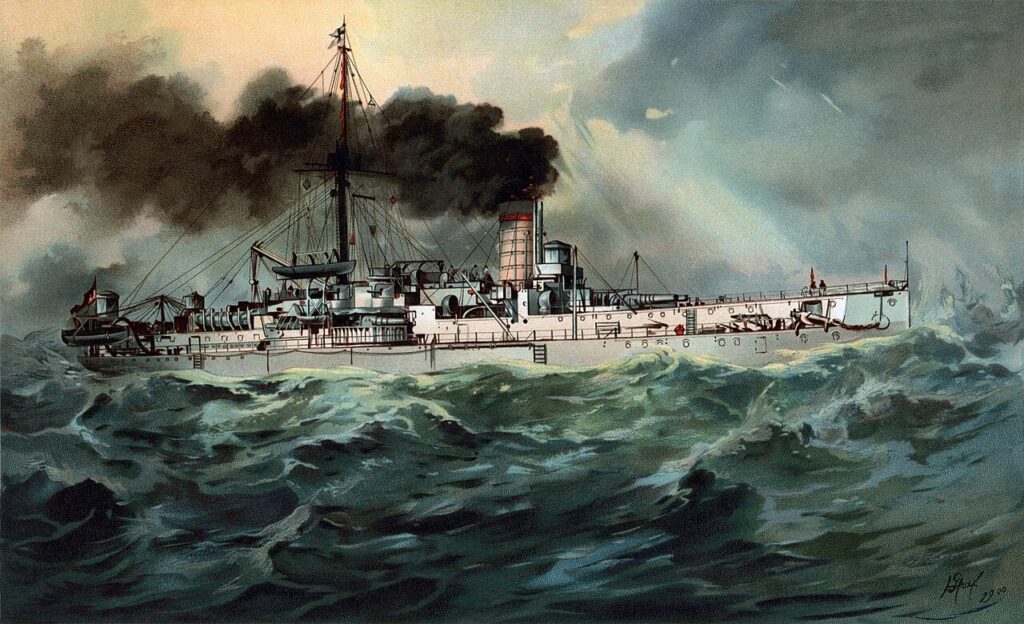
Painting of Baden after her reconstruction, by Willy Stöwer
Overhaul went on until recommissioned on 19 November 1897 under KzS Oskar Stiege. She was in I Squadron in 1896, as divisional flagship from 30 November with Württemberg, Oldenburg, the aviso Greif, under KAdm Felix von Bendemann. On 24 June 1898, she collided with the protected cruiser Hertha. Under KAdm Weitersheim she damaged one of her propellers off Skagen in Denmark by July 1899, drydocked. Later she greeted two Italian cruisers visiting Kiel in September under FK Carl Franz. She was versed into the Reserve Division of the North Sea with Sachsen and Württemberg and later under KsZ August von Heeringen she was in I Squadron (replaing the Brandenburg-class sent to China for the Boxer Uprising) as flagship of the squadron deputy commander KAdm Max von Fischel. She was sent in the Netherlands wirth the cruiser Freya for the marriage celebrations of Queen Wilhelmina and Duke Henry of Mecklenburg-Schwerin. Later with the coastal defense ship Hagen, protected cruiser Victoria Louise, aviso Jagd she visited US for the ceremonies after the death of Queen Victoria, back home in July 1901.
Back in the II Squadron she took part in the annual fleet maneuvers with the III and IV Divisions, and the Reserve Division of the North Sea in Wilhelmshaven. In July 1902 she accidentally rammed the pre-dreadnought Wittelsbach while fitting out. She was kept flagship of II Squadron for the fleet maneuvers (konteradmiral Ernst Fritze) with her sister Württemberg, the coastal defense nattleship Hagen, Hildebrand, Heimdall, and Beowulf. Active from 4 July 1903 she was the flagship of II Squadron and after 12 September, she sailed to Kiel for decommission on 28 September. She was in the 1st reserve until 1906, then 2nd reserve, stricken on 24 October 1910, and from early 1911, became a target ship before being converted in February to a mine storage hulk with instructional and barracks rooms for the mine warfare school at Cuxhaven. On 3 August 1913, she was towed to Brunsbüttel and became a coastal defense hulk. By January 1916 she was stationed at Altenbruch as guard ship until June 1918. In 1920, she was converted into a target hulk off Stollergrund and was sold on 23 April 1938, BU 1939–1940 in Kiel, the last of her class still around.
Read More/Src
Books
Dodson, Aidan (2016). The Kaiser’s Battlefleet: German Capital Ships 1871–1918. Seaforth Publishing.
Gröner, Erich (1990). German Warships: 1815–1945. Vol. I: Major Surface Vessels. NIP
Hildebrand, Hans H.; Röhr, Albert & Steinmetz, Hans-Otto (1993). Die Deutschen Kriegsschiffe. Mundus Verlag.
Hovgaard, William (1971). Modern History of Warships. London: Conway Maritime Press.
Lyon, Hugh (1979). “Germany”. Gardiner, Robert; Chesneau, Roger; Kolesnik, Eugene M. (eds.). Conway’s All the World’s Fighting Ships 1860–1905.
Sondhaus, Lawrence (1997). Preparing for Weltpolitik: German Sea Power Before the Tirpitz Era. Naval Institute Press.
Wright, Richard N.J. (2000). The Chinese Steam Navy. London: Chatham Publishing.
Erwin Strohbusch: Deutsche Marine. Kriegsschiffbau seit 1848.
Erich Gröner, Dieter Jung und Martin Maass: Die deutschen Kriegsschiffe 1815–1945 – Band 1. Bernard & Graefe Verlag 1982
Links
dreadnoughtproject.org
navypedia.org/
en.wikipedia.org
commons.wikimedia.org/ Sachsen-Klasse_(1875)
navwar.co.uk/nav/


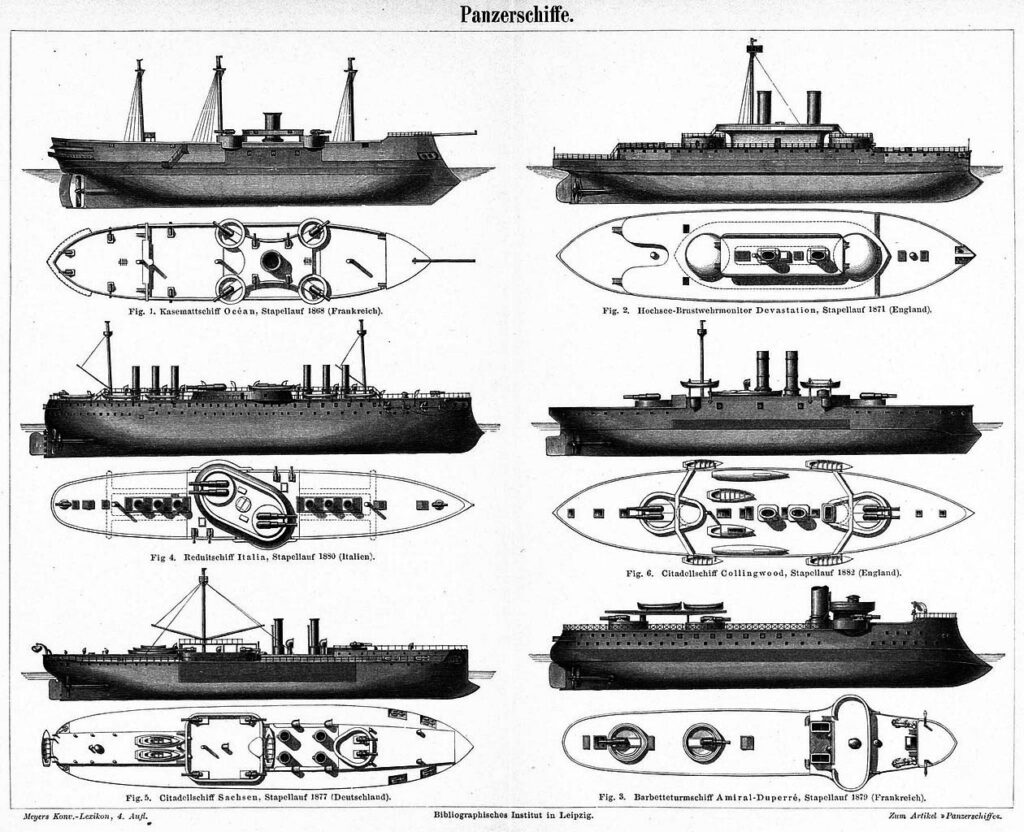
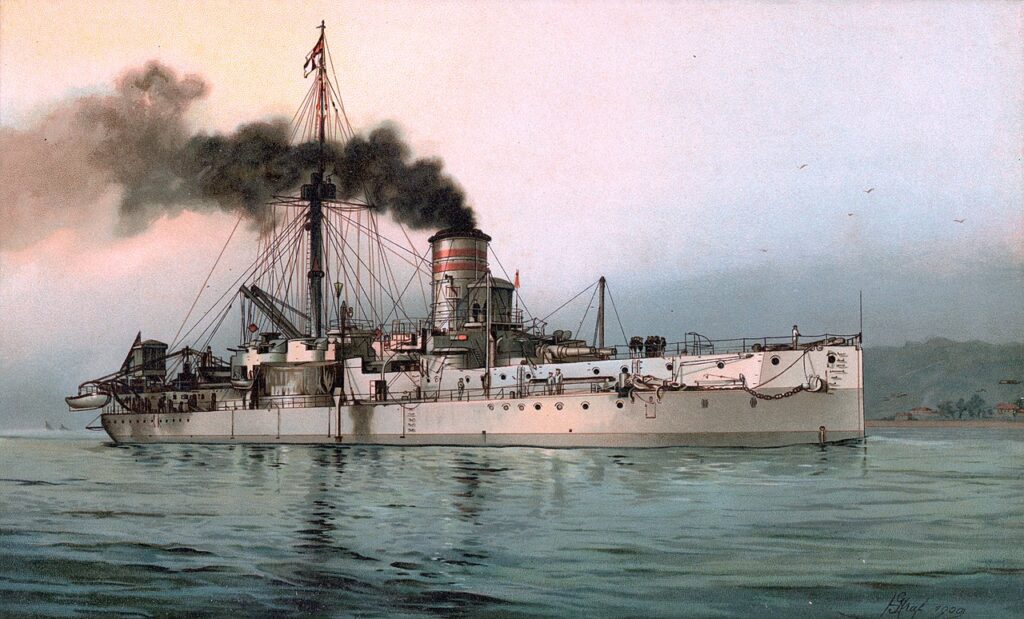
 Latest Facebook Entry -
Latest Facebook Entry -  X(Tweeter) Naval Encyclopedia's deck archive
X(Tweeter) Naval Encyclopedia's deck archive Instagram (@navalencyc)
Instagram (@navalencyc)





 French Navy
French Navy Royal Navy
Royal Navy Russian Navy
Russian Navy Armada Espanola
Armada Espanola Austrian Navy
Austrian Navy K.u.K. Kriegsmarine
K.u.K. Kriegsmarine Dansk Marine
Dansk Marine Nautiko Hellenon
Nautiko Hellenon Koninklije Marine 1870
Koninklije Marine 1870 Marinha do Brasil
Marinha do Brasil Osmanlı Donanması
Osmanlı Donanması Marina Do Peru
Marina Do Peru Marinha do Portugal
Marinha do Portugal Regia Marina 1870
Regia Marina 1870 Nihhon Kaigun 1870
Nihhon Kaigun 1870 Preußische Marine 1870
Preußische Marine 1870 Russkiy Flot 1870
Russkiy Flot 1870 Svenska marinen
Svenska marinen Søværnet
Søværnet Union Navy
Union Navy Confederate Navy
Confederate Navy Armada de Argentina
Armada de Argentina Imperial Chinese Navy
Imperial Chinese Navy Marinha do Portugal
Marinha do Portugal Mexico
Mexico Kaiserliche Marine
Kaiserliche Marine 1898 US Navy
1898 US Navy Sovietskiy Flot
Sovietskiy Flot Royal Canadian Navy
Royal Canadian Navy Royal Australian Navy
Royal Australian Navy RNZN Fleet
RNZN Fleet Chinese Navy 1937
Chinese Navy 1937 Kriegsmarine
Kriegsmarine Chilean Navy
Chilean Navy Danish Navy
Danish Navy Finnish Navy
Finnish Navy Hellenic Navy
Hellenic Navy Polish Navy
Polish Navy Romanian Navy
Romanian Navy Turkish Navy
Turkish Navy Royal Yugoslav Navy
Royal Yugoslav Navy Royal Thai Navy
Royal Thai Navy Minor Navies
Minor Navies Albania
Albania Austria
Austria Belgium
Belgium Columbia
Columbia Costa Rica
Costa Rica Cuba
Cuba Czechoslovakia
Czechoslovakia Dominican Republic
Dominican Republic Haiti
Haiti Hungary
Hungary Honduras
Honduras Estonia
Estonia Iceland
Iceland Eire
Eire Equador
Equador Iran
Iran Iraq
Iraq Latvia
Latvia Liberia
Liberia Lithuania
Lithuania Mandchukuo
Mandchukuo Morocco
Morocco Nicaragua
Nicaragua Persia
Persia San Salvador
San Salvador Sarawak
Sarawak Uruguay
Uruguay Venezuela
Venezuela Zanzibar
Zanzibar Warsaw Pact Navies
Warsaw Pact Navies Bulgaria
Bulgaria Hungary
Hungary

 Bundesmarine
Bundesmarine Dutch Navy
Dutch Navy Hellenic Navy
Hellenic Navy Marina Militare
Marina Militare Yugoslav Navy
Yugoslav Navy Chinese Navy
Chinese Navy Indian Navy
Indian Navy Indonesian Navy
Indonesian Navy JMSDF
JMSDF North Korean Navy
North Korean Navy Pakistani Navy
Pakistani Navy Philippines Navy
Philippines Navy ROKN
ROKN Rep. of Singapore Navy
Rep. of Singapore Navy Taiwanese Navy
Taiwanese Navy IDF Navy
IDF Navy Saudi Navy
Saudi Navy Royal New Zealand Navy
Royal New Zealand Navy Egyptian Navy
Egyptian Navy South African Navy
South African Navy






























 Ukrainian Navy
Ukrainian Navy dbodesign
dbodesign